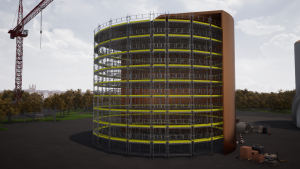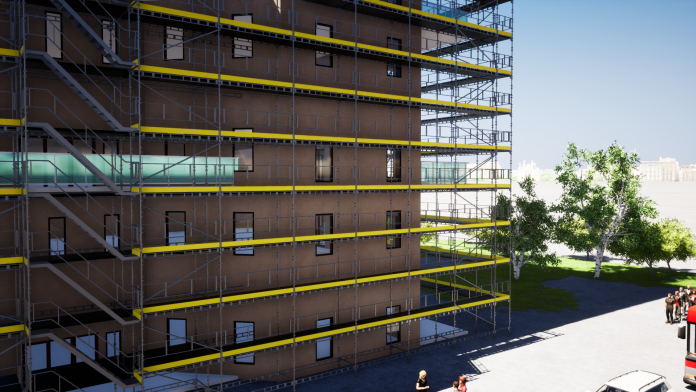Mattias Kuduk, VDC and innovation manager at global temporary access provider HAKI, discusses the technologies that are having a positive impact on a sector where safety, quality and performance are high demands on a project’s agenda
Technology is enabling the wider construction industry to achieve so much; it is streamlining delivery, reducing risk and driving productivity across a project’s supply chain. BIM, virtual/augmented reality and IoT (Internet of Things) are now common terms within the industry’s vocabulary, with some if not all construction sectors now using at least one of these technologies in their daily operations.
For the scaffold and temporary access sector, technology is reinventing the wheel, with BIM in particular enabling clients to interact with impressive 3D models of intricate designs.
Simple designs for complex structures
BIM is giving a project’s entire supply chain improved visibility when it comes to planning, designing and managing built assets. From enabling architects to design-out risk to providing contractors with the capability to digitise construction sites, this intelligent 3D model is optimising work processes and collaboration in a notoriously disjointed industry. Not only is it bringing the construction industry into the modern age, BIM is also improving the levels of safety in which buildings are made and maintained. In a post-Grenfell society, we all know how essential its presence is.

For the scaffold and temporary access industry, BIM is enabling internal and external design engineers to produce simple 3D scaffolding blueprints for complex structures. Unlike 2D CAD drawings, 3D modelling produces detailed designs in far less time and with more reliability.
Designers can reap these benefits with the tools such as the HAKI Design Tool and HAKI BIM; two solutions in which the former enables designers to configure scaffolding designs on a cloud-based platform – Inventor iLogic and Configurator 360 from Autodesk – and the latter advances this configuration on to Revit for greater customisation and capability, particularly when it comes to interacting with the components within the 3D model.
As BIM progresses, the scaffold and temporary access industry will see the wider adoption of 4D, 5D and 6D iterations. HAKI is currently engaging in 6D BIM on Hinkley Point C (HPC), the UK’s newest nuclear power site. This version is processing live connections to the sites to inform decision-making. Each week a site is scanned for updates, where this data is assimilated and then disseminated to the project’s supply chain, meaning weekly progressions can be viewed. With 6D BIM, the HPC project’s supply chain has full visibility of a project, which is currently the largest construction site in Europe.
Visualising the future
On construction projects, virtual or augmented reality (VR/AR) gives a clear visualisation of how a project will function in real-life. A project’s 3D BIM model is loaded on to the AR software to give full visibility of the components. Users can then interact and walk through the ‘project world’ to review the work prior to construction. This process adds another crucial layer to scaffold projects, enabling designs to be viewed and interrogated before moving to the next stage of development.
HAKI has developed a version of such software named HAKI Playground, which allows users to walk around the project directly onscreen. This can be used on any device including a PC, tablet, smartphone, Xbox and PlayStation.
After a project has been completed in Revit or HAKI BIM, it can be exported to the gaming platform Unity. An avatar lets the user walk around the project as if it was in the real world. The user can, for instance, see the detail of a scaffolding beam and analyse its compatibility with fellow materials, enabling money to be saved and risk to be mitigated on projects. To provide even greater accessibility, the HAKI app is making use of smartphone technology to enable its customers to view products in AR, in order to find information quickly.
As well as being suitable for a number of devices, HAKI Playground negates the need for any headsets with glasses – a real bonus for those constantly moving around a project. The application also allows a number of stakeholders in the supply chain to experience the solution in VR at any one time and is not restrictive to one person, unlike most other applications. This is particularly beneficial for group environments and collaborative or collective feedback.
Keeping connected onsite
The Internet of Things basically encompasses every and any object that uses the internet to connect with another ‘thing’. Smartphones, Fitbits, Amazon Echo, each household has at least one of these objects (which are in constant dialogue with another). For the construction industry, the IoT has radically changed the way projects are managed and built; there are apps for project management, deliveries, timesheets etc. IoT is essentially allowing important decisions to be made anytime, anywhere, freeing up site-workers from the shackles of their office computers so work can be performed in any location with decent Wi-Fi.
IoT is of particular value on temporary access projects on offshore oil rigs, or any programme of works that are located in hard-to-reach places. Having a device which can keep these sites connected with external supply chains is crucial, especially when it comes to deliveries and any other urgent matters.
BIM, AR and IoT technologies are just a few of the innovations that are streamlining programmes of temporary access works across the globe. Preventing risk, improving project delivery and offering real value, it won’t be long before technology is completely indispensable to the sector.
Mattias Kuduk
VDC and innovation manager
HAKI
+44 (0)1827 282 525
Twitter: @HAKIscaffolding
LinkedIn: HAKI Scaffolding
YouTube: HAKI Scaffolding

















